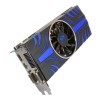- Qualcomm Launches Snapdragon 4 Gen 2 Mobile Platform
- AMD Launches Ryzen PRO 7000 Series Mobile & Desktop Platform
- Intel Launches Sleek Single-Slot Arc Pro A60 Workstation Graphics Card
- NVIDIA Announces Latest Ada Lovelace Additions: GeForce RTX 4060 Ti & RTX 4060
- Maxon Redshift With AMD Radeon GPU Rendering Support Now Available
Sapphire Radeon HD 5850 Toxic

AMD’s Radeon HD 5850 may not be the company’s highest-end card, but it still packs a wicked punch. Plus, when overclocked, and overclocked well, it can come close to the peformance of the top-end HD 5870. With the design of Sapphire’s Toxic graphics card, hitting heights like this seem to be made all too simple.
Page 11 – Overclocking Sapphire’s Radeon HD 5850 Toxic
Before tackling our overclocking results, let’s first clear up what we consider to be a real overclock and how we go about achieving it. If you read our processor reviews, you might already be aware that we don’t care too much for an unstable overclock. It might look good on paper, but if it’s not stable, then it won’t be used. Very few people purchase a new GPU for the sole purpose of finding the maximum overclock, which is why we focus on finding what’s stable and usable.
To find the max stable overclock on an ATI card, we stick to using ATI’s Catalyst Overdrive tool. Compared to what’s available on the NVIDIA side, it’s quite limited in the top-end, but it’s the most robust and simplest solution to use. For NVIDIA, we use EVGA’s Precision, which allows us to reach heights that are in no way sane – a good thing.
Once we find what we believe might be a stable overclock, the card is put through 30 minutes of torture with the help of OCCT 3.0’s GPU stress-test, which we find to push any graphics card harder than any other stress-tester we’ve ever used. If the card passes there, we then further verify by running the card through a 2x run of 3DMark Vantage’s Extreme setting. Finally, games are quickly loaded and tested out to assure we haven’t introduced any side-effects.
If all these tests pass without issue, we consider the overclock to be stable.
Overclocking Sapphire’s Radeon HD 5850 Toxic
Overclocking pre-overclocked cards is always interesting, because sometimes the card will overclock quite a bit further, and other times it might not overclock much further at all. In the case of our Toxic card here, the former is true, and I have to say, the results were impressive. The reference clocks for the HD 5850 are 725MHz Core and 1000MHz, and the pre-overclock on the Toxic bumps those to 765MHz and 1125MHz, respectively. After much tweaking, we managed to land a stable overclock of 870MHz and 1225MHz. That’s a 105MHz Core and 100MHz Memory boost, on an already-overclocked card!
Note that in order to achieve these clocks, we had to use AMD’s own GPU Clock Tool, as the Overdrive utility in the Catalyst driver only allowed us a mere 10MHz boost above the 765MHz Core, and no additional frequency on the memory, which I’m sure is why Sapphire didn’t go beyond the clocks it did.
Because our overclocks were so impressive, I’m not going to say that I believe them to be truly typical, but in our case, those clocks were absolutely stable, and I tried hard to break it. They passed everything, from our continuous OCCT run to our looped 3DMark run to our real-world gaming runs. The clocks we reached were undoubtedly impressive, but were they worth it?


For once, I can say “yes”, because the gains seen in our games and 3DMark runs above are without question notable. We saw a 6 FPS bump in Modern Warfare 2, 10 FPS increase in F.E.A.R. 2, and likewise, another 10 FPS increase in GRID. I of course wouldn’t heartily recommend anyone to overclock their GPU so high on a regular basis, but should you choose to, real performance gains can be seen.
Support our efforts! With ad revenue at an all-time low for written websites, we're relying more than ever on reader support to help us continue putting so much effort into this type of content. You can support us by becoming a Patron, or by using our Amazon shopping affiliate links listed through our articles. Thanks for your support!





